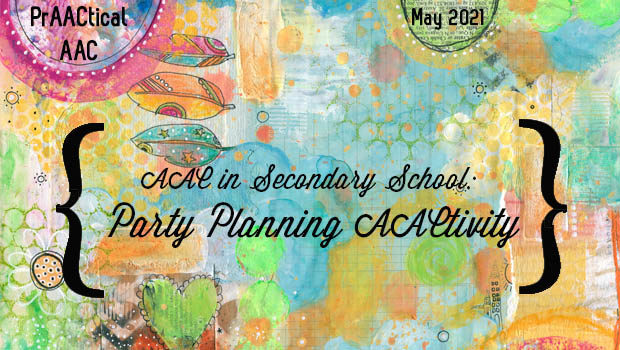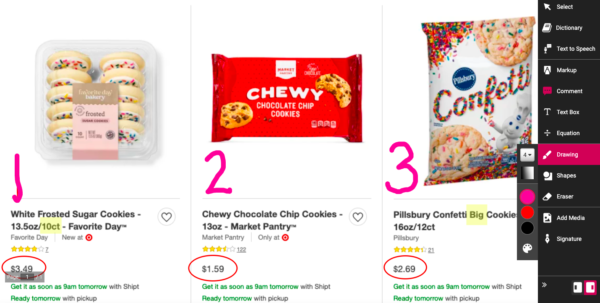AAC in Secondary School: Party Planning AACtivity

Today, we welcome back AAC SLP Ashley Larisey to these pages for another post in the AAC in Secondary School series. Ashley is an SLP at Community High School District 218 in Oak Lawn, Illinois. She is also an Adjunct Clinical Supervisor and Instructor at Saint Xavier University. Additionally, Ashley presents on AAC topics at professional conferences.
Community High School District 218 in Oak Lawn, Illinois. She is also an Adjunct Clinical Supervisor and Instructor at Saint Xavier University. Additionally, Ashley presents on AAC topics at professional conferences.
In today’s post, she shares thoughts on using party planning as an activity for teaching language and AAC skills.
Enjoy!
::::::::::::::::::::::::::::::::::::::::::::::::::::::::::::::::::::::::::::::::::::::::::::::::::::::::::::::::::::::
Party Planning
If you work in the schools, the end of the school year is right around the corner! The month of May is generally full of celebrations to culminate a year’s worth of hard work for staff and students alike. For high school students, this can also include celebrations surrounding graduation. Parties are often planned by educational staff, but why not bring students into the process? Party planning is full of language opportunities within a highly motivating context that is personally meaningful to all students – including AAC users! So – invite your students to be members of the party planning committee – and let’s talk about some fun and engaging ways to embed language into your party planning AACtivities!
Still remote? Have restrictions on in-person gatherings due to COVID-19? Read on – you’ll find some tips for everyone!
FORM THE COMMITTEE!
…but, what IS a committee? This is great time to use descriptive teaching (Van Tatenhove, 2009) to talk about the meaning of the word “committee”. I like to use google and the search term “define: WORD” to see what core vocabulary I can use to teach the meaning of a Tier 2 or Tier 3 vocabulary word. Some suggestions would be to use words like “some people help”, “get together”, or “make better” to describe a committee. You can choose to designate specific roles (menu planning, music, invitations) to specific students or work on the planning tasks in small groups.
PLAN THE MENU
Involve your students in selecting the food and drinks that will be available for the party. If you are celebrating graduates, this is a great time to practice asking the graduates what their favorite snacks and drinks are, so that the party planning committee can purchase them in advance. If your party has a more general “end of the year” theme, language surveys can be used to poll the guests to determine which are most popular and could be purchased for the party. When planning parties to celebrate cultural heritage months or holidays, researching meals that might traditionally be served within different cultures can be part of the learning process. Creating a guest list to determine how many people will be coming is also which can help guide how much food/drink will need to be purchased.
Still remote? That’s ok! Work with the AAC user and their family to plan for something that they can bring to the party. You can also skip food entirely if that is not an option – check out some other ideas for AACtivities for the initial planning process below:
Tarheel Reader Books: (Shared Reading)
Predictable Chart Writing:
Possible stems: I will buy ______., We will eat ______., Parties make me feel ______.
Language Survey:
What is your favorite snack?, Where should we have the party?
SEND INVITATIONS
A planning sheet can be used to work through lots of different planning aspects such as:
- WHO will be attending
- WHEN will the party take place
- WHAT some activities (actions!) will be (eating, dancing, etc.)
- WHERE the party will take place
- WHY we are celebrating!
This information can all be included within invitations. There are many options for designing and sending out invitations. Check out a few listed below:
- Email: e-mail capabilities are integrated into many robust AAC systems and will provide students with the opportunity to practice some of the different aspects of sending an e-mail such as creating a subject (…the main idea!) and adding a signature.
- Creating Announcements: Does your classroom have a shared social media page or other classroom management programs like Seesaw or Google classroom? Use these tools to send out the invitations when applicable.
- Canva: Using Canva is a great way to design your own invitation that can be printed or sent electronically. The creation of invitations/flyers is age-respectful and there are many pre-created templates are available within Canva. Students can play an active role in the design, font pairings, graphics, and even use of animation!

DECORATIONS
Keep your theme at the center of your decoration planning. Look at pictures of different “parties” to talk about the clues that we see and how they help identify what is being celebrated (birthday/graduation/holiday or commemorative observance). If you are celebrating graduation, brainstorm examples vs. non-examples of things that could be used to decorate for a graduation party. You can also provide opportunities to shop for decorations if possible (see Step 5 below!)
Another easy and free way to decorate is by embedding art projects! For example, if you are celebrating graduates, work with students to use 1-2 positive descriptors to describe the person and assemble those into a word cloud to be printed and given to the graduate at the party. 
SHOPPING
Create lists to shop for the items – food, décor, and anything else you’ll need! These can be handwritten, typed, created with an alternative pencil, or even drafted using apps or smart assistants (idea: Alexa shopping lists!). If you are shopping as a group in the community, assign 1-2 items per student and gather everything you’ll need for the party.
If you’re still working remotely with students, doing this as a group activity using websites like Instacart or a grocery store curbside pickup delivery service will allow students to shop virtually for items so they can be picked up at a later time. Lots of communication, language, and literacy opportunities exist when shopping, including requesting assistance, categorization (aisle organization), creating and referencing shopping lists, and conceptual understanding (more vs. less).

Target shopping choices being annotated with Kami to compare options
MUSIC
What’s a party without music? There is SO much that we can do with music – here are a few ideas!
- What is your theme? If the theme is “graduation” – a google search of “songs about graduation” will bring up several options. The same can go for just about any other celebration, whether it be a birthday party, cultural celebration, or holiday. Listen to some songs and talk about if your students like/don’t like them, how the student makes them feel, and if it should be added to the playlist. Don’t forget to dance!
- Songs can be used for embedded literacy instruction in terms of alphabet knowledge and phonological awareness. Print out the lyrics of a song that you will be discussing. Take some time to explore the lyrics of one of the songs by examining rhymes and using print referencing to bring attention to various different concepts of print.
- Keep a list of songs to create a playlist using Spotify or Pandora. You can create a custom routine using Alexa so that students can start the playlist when the party is ready to start!
PARTY!
Your party will be a huge success thanks to the party planning committee – and you’ll have provided several opportunities for language and communication throughout the process. Have fun!
References
Erickson, K. A., & Koppenhaver, D. (2020). Comprehensive literacy for all: Teaching students with significant disabilities to read and write. Baltimore, MD: Paul H. Paul H. Brookes Brookes Publishing.
Van Tatenhove. G. (2009). Building Language Competence with Students Using AAC Devices: Six Challenges. Perspectives on Augmentative and Alternative Communication, 18(2), 38-47.
Filed under: Featured Posts, PrAACtical Thinking
This post was written by Carole Zangari

1 Comment
I would love to have some thoughts on using AAC with a verbal child who is very prompt dependent. He has been using an iPad to make quick requests (in sentence form) but I am not sure if I am going down the right path.